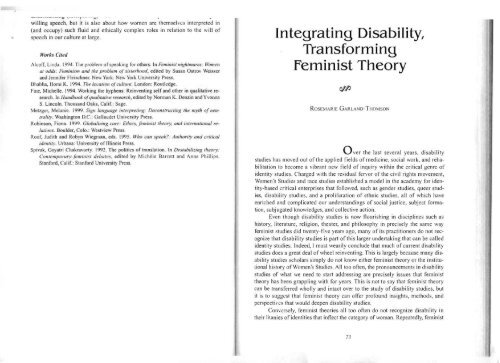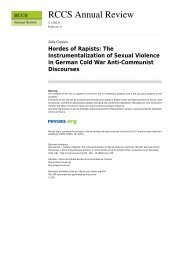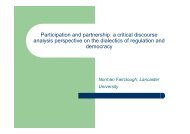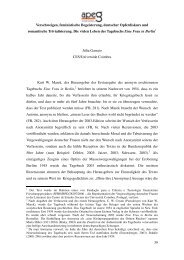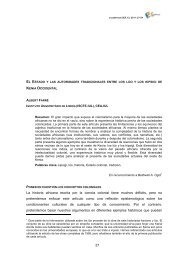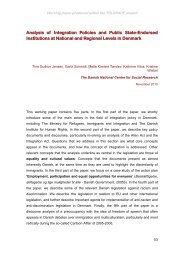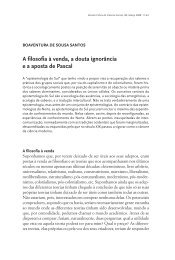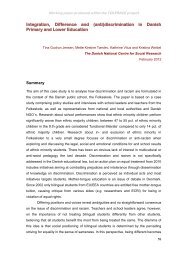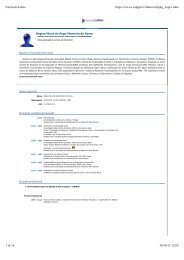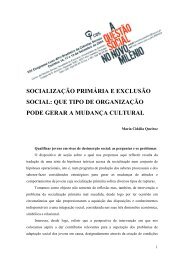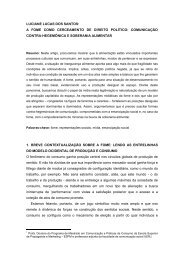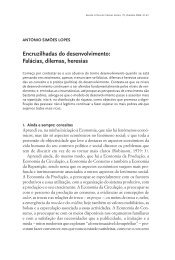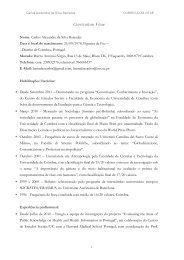Integrating Disability, Transforming Feminist Theory
Integrating Disability, Transforming Feminist Theory
Integrating Disability, Transforming Feminist Theory
Create successful ePaper yourself
Turn your PDF publications into a flip-book with our unique Google optimized e-Paper software.
\. --- - - - r - - ---0 ·'<br />
willing speech, 'but it is also about how women are themselves interpreted in<br />
(and occupy) such fluid and ethically complex roles in relation to the will of<br />
specch in our culture at large.<br />
Works Cited<br />
Alcoff, Linda. 1994. The problem of speaking for others. In Feminislnighlmares: Women<br />
al odds: Feminism and Ihe problem o{sislerhood, edited by Susan Ostrov Weisser<br />
and Jennifer Fleischner. New York : New York University Press.<br />
Bhabha, Homi K. 1994. The localioll OrCllllure. London: Routledge.<br />
Fine, Michelle. 1994. Working the hyphens: Reinventing self and other in qualitative research.<br />
In lIundbook o{'lualilalive research , edited by Norman K. Denzin and YVOIUla<br />
S. Lincoln. Thousand Oaks, Calif.: Sage.<br />
Metzger, MeI
74 Rosemarie Garland-Thomson<br />
issues that are intril:ately entangled with disability- such as reproductive technology,<br />
the place of bodily differences, the particularities of oppression, the ethics<br />
of care, the construction of the subject-are discussed without any reference<br />
to disability. Like disability studies practitioners who are unaware of feminism,<br />
feminist scholars are often simply unacquainted with disability studies' perspectives.<br />
The most sophisticated and nuanced analyses of disability, in my view,<br />
come from scholars conversant with feminist theory. And the most compelling<br />
and complex analyses of gender intersectionality take into consideration what<br />
[ call the ability/disability system-along with race, ethnicity, sexuality, and<br />
class.<br />
[ want to give the omissions r am describing here the most generous interpretation<br />
I can. The archive, Foucault has shown us, determines what we can<br />
know. There has bcen no archive, no template for understanding disability as a<br />
category of analysis and knowledge, as a cultural trope, and an historical community.<br />
So just as the now widely recognized centrality of gender and race analyses<br />
to all knowledge was unthinkable thirty years ago, disability is still not an<br />
icon on many critical desktops. [ think, however, that feminist theory'S omission<br />
of disability differs from disability studies' ignorance of feminist theory. I<br />
find feminist theory anc! those familiar with it quick to grasp the broad outlines<br />
of disability theory and eager to consider its implications. This, of course, is<br />
because feminist theory itself has undertaken internal critiques and proved to<br />
be porous and flexible. <strong>Disability</strong> studies is news, but feminist theory is not.<br />
Nevertheless, feminist theory is still resisted for exactly the same reasons that<br />
scholars might resist disability studies: the assumption that it is narrow, p3l1icular,<br />
and has little to do with the mainstream of academic practice and knowledge<br />
(or with themselves). This reductive notion that identity studies are intellectual<br />
ghettos limited to a narrow constituency demanding special pleading is the persistent<br />
obstacle that both feminist theory and disability studies must surmount.<br />
<strong>Disability</strong> studies can benefit from feminist theory and feminist theory<br />
can benefit from disability studies. Both feminism and disability studies are comparative<br />
and concurrent academic enterprises. Just as feminism has expanded<br />
the lexicon of what we imagine as womanly, has sought to understand and<br />
destigmatize what we call the subject position of woman, so has disability studies<br />
examined the identity disabled in the service of integrating people with disabilities<br />
more fully into our society. As such, both are insurgencies that are<br />
becoming institutionali zed, underpinning inquiries outside and inside the academy.<br />
A feminist disability theory builds on the strengths of both .<br />
<strong>Feminist</strong> <strong>Disability</strong> <strong>Theory</strong><br />
My title here, "<strong>Integrating</strong> <strong>Disability</strong>, <strong>Transforming</strong> <strong>Feminist</strong> <strong>Theory</strong>," invokes<br />
and links two notions, integration and transformation , both of which are<br />
fundamental to the feminist project and to the largcr civil rights movement that<br />
<strong>Integrating</strong> <strong>Disability</strong> 75<br />
informed it. Integration suggests achieving parity by fully including that which<br />
has been excluded and subordinated. Transformation suggests reimagining<br />
establ ished knowledge and the order of things. By alluding to integration and<br />
transformation, [ set my own modest project of integrating disability into feminist<br />
theory in the politicized context of the civil rights movement to gesture toward<br />
the explicit relation that feminism supposes between intellectual work and<br />
a commitment to creating a more just, equitable, and integrated society.<br />
This chapter aims to amplify feminist theory by articulating and fostering<br />
femini st disability theory. In naming feminist disability studies here as an academic<br />
field of inquiry, [ am sometimes describing work that is already underway,<br />
some of which explicitly addresses disability, and some of which gestures<br />
implicitly to the topic. At other times, I am calling for study that needs to be<br />
done to better illuminate feminist thought. In other words, this chapter, in part,<br />
sets an agenda for future work in feminist disabi lity theory. Most fundamentally,<br />
though, the goal of feminist disability studies, as [ lay it out in this chapter,<br />
is to augment the terms and confront the limits of the ways we understand<br />
human diversity, the materiality of the body, multiculturalism, and the social formations<br />
that interpret bodily differences. The fundamental point I will make here ·<br />
is that integrating disability as a category of analysis and a system of representation<br />
deepens, expands, and challenges feminist theory.<br />
Academic feminism is a complex and contradictory matrix of theories,<br />
strategies, pedagogies, and practices. One way to think about feminist theory is<br />
to say that it investigates how culture saturates the particularities of bodies with<br />
meanings and probes the consequences of those meanings. <strong>Feminist</strong> theory is a<br />
collaborative, interdisciplinary inquiry and a self-conscious cultural critique that<br />
interrogates how subjects are multiply interpellated: in other words, how the representational<br />
systems of gender, race, ethnicity, ability, sexuality, and class mutually<br />
construct, inflect, and contradict one another. These systems intersect to<br />
produce and sustain ascribed, achieved, and acquired identities-both those that<br />
claim us and those that we claim for ourselves. A feminist disability theory introduces<br />
the ability/disability system as a category of analysis into this diverse<br />
and diffuse enterprise. It aims to extend current notions of cultural diversity and<br />
to more fully integrate the academy and the larger world it helps shape.<br />
A feminist disability approach fosters complex understandings of the cultural<br />
history of the body. By considering the ability/disability system, feminist<br />
disability theory goes beyond explicit disability topics such as illness, health,<br />
beauty, genetics, eugenics, aging, reproductive technologies, prosthetics, and access<br />
issues. <strong>Feminist</strong> disability theory addresses such broad feminist concerns<br />
as the unity of the category woman , the status of the lived body, the politics of<br />
appearance, the medicalization of the body, the privilege of normalcy, multiculturalism,<br />
sexuality, the social construction of identity, and the commitment<br />
to integratiolJ. To borrow Toni Morrison's (1992) notion that blackness is an idea<br />
that permeates American culture, disability too is a pervasive, often unal1iculatl:cL
76 Rusemarie Garland-Tholl/so/7<br />
ideology informing our cultural notions of self and other. <strong>Disability</strong> - like gender-<br />
-is a concept that pervades all aspccts of culture: its structuring institutions,<br />
social identities, cultural practices, political positions, historical communities,<br />
and the shared human experience of embodiment.<br />
<strong>Integrating</strong> disability into feminist theory is generative, broadening our collective<br />
inquiries, questioning our assumptions, and contributing to feminism's<br />
intcrscctionality. Introducing a disability analysis does not narrow the inquiry,<br />
limit the focus to only women with disabilities, or preclude engaging other manifestations<br />
of feminisms. Indeed, the multiplicity of foci we now call feminisms<br />
is not a group of fragmented, competing subfields but rather a vibrant, complex<br />
conversation. In talking about feminist disability theory, I am not proposing yet<br />
another discrete feminism but suggesting instead some ways that thinking about<br />
disability transforms feminist theory. <strong>Integrating</strong> disability does not obscure our<br />
critical focus on the registers of race, sexuality, ethnicity, or gender, nor is it<br />
additive. Rather, considering disability shifts the conceptual framework to<br />
strengthen our understanding of how these mUltiple systems intertwine, redefine,<br />
and mutually constitute one another. <strong>Integrating</strong> disability clarifies how<br />
this aggregate of systcms operates together, yet distinctly, to support an imaginary<br />
norm and structure of the relations that grant power, privilege, and status<br />
to that norm. rndeed, the cultural function of the disabled figure is to act as a<br />
synecdoche for all forms that culture deems nonnormative.<br />
We need to study disability in a feminist context to direct our highly honed<br />
critical skills toward the dual scholarly tasks of unmasking and reimagining disability,<br />
not only for people with disabilities, but for everyone. As Simi Linton<br />
(1998) puts it, studying disability is "a prism through which one can gain a<br />
broader understanding of society and human experience" (118). It deepens our<br />
understanding of gender and sexuality, individualism and equality, minority group<br />
definitions, autonomy, wholeness, independence, dependence, health, physical<br />
appearance, aesthetics, the integrity of the body, community, and ideas of<br />
progress and perfection in every aspect of cultures. A feminist disability theory<br />
introduces what Eve Sedgwick (1990) has called a "universalizing view" of disability<br />
that will rcplacc an often persisting "minoritizing view." Such a view will<br />
cast disability as "an issue of continuing, determinative importance in the lives<br />
of people across the spectrum" (I). In other words, understanding how disability<br />
operates as an identity category and cultural concept will enhance how we<br />
understand what it is to be human, our relationships with one another, and the<br />
experience of embodiment. The constituency for feminist disability studies<br />
is all of us, not only women with disabilities: disability is the most human of experiences,<br />
touching every family and-if we live long enough-touching us all.<br />
The Abilityl<strong>Disability</strong> System<br />
<strong>Feminist</strong> disability theory'S radical critique hinges on a broad understanding<br />
of disability as a pervasive cultural system that stigmatizes certain kinds of bodily<br />
llliegruling DisabililV 77<br />
variations. At the same time, this system has the potential to incite a critical politics.<br />
The informing premise of feminist disability theory is that disability, like<br />
femaleness, is not a natural state of corporeal infcriority, inadequacy, excess, or<br />
a stroke of misfortune. Rather, disability is a culturally fabricated narrative of<br />
the body, similar to what we understand as the fictions of race and gender. The<br />
disability/ability system produces subjects by differentiating and marking bodies.<br />
Although this comparison of bodies is ideological rather than biological, it<br />
nevertheless penetrates into the formation of culture, legitimating an unequal<br />
distribution of resources, status, and power within a biased social and architectural<br />
cnvironment. As such, disability has four aspects: first, it is a system for<br />
intcrpreting and disciplining bodily variations; second, it is a rclationsh,ip between<br />
bodies and their environments; third, it is a set of practices that produce<br />
both the able-bodied and the disabled; fourth, it is a way of describing the inherent<br />
instability of the embodied self. The disability system excludes the kinds<br />
of bodily forms, functions, impairments, changes, or ambiguities that call into<br />
question our cultural fantasy of the body as a neutral, compliant instrument<br />
of some transcendent will. Moreover, disability is a broad term within which<br />
cluster ideological categories as varied as sick, deformed, crazy, ugly, old,<br />
maimed, afflicted, mad, abnormal, or debilitated-all of which disadvantage<br />
people by devaluing bodies that do not conform to cultural standards. Thus,<br />
the disability system functions to preserve and validate such privileged designations<br />
as beautiful, healthy, normal, fit, competent, intelligent-all of which<br />
provide cultural capital to those who can claim such status, who can reside within<br />
these subject positions. It is, then, the various interactions between bodies and<br />
world that materialize disability from the stuff of human variation and precariousness.<br />
A feminist disability theory denaturalizes disability by unseating the dominant<br />
assumption that disability is something that is wrong with someone. By<br />
this I mean, of course, that it mobilizes feminism's highly developed and complex<br />
critique of gender, class, race, ethnicity, and sexuality as exclusionary and<br />
oppressive systems rather than as the natural and appropriate order of things.<br />
To do this, feminist disability theory engages several of the fundamental premises<br />
of critical theory: (a) that rcpresentation structures reality, (b) that the margins<br />
define the center, (c) that gender (or disability) is away of signifying<br />
relationships of power, (d) that human identity is multiple and unstable, (e) that<br />
all analysis and evaluation have political implications.<br />
To elaborate on these premises, I discuss here four fundamental and<br />
interpenetrating domains of feminist theory and suggest some of the kinds of<br />
critical inquiries that considering disability can generate within these theoretical<br />
arenas. These domains are: (a) representation, (b) the body, (c) identity,<br />
and (d) activism . While [ have disentangled thcse domains here for the purposes<br />
of' setting up a schematic organization for my analysis, these domains are,<br />
of course, not discrete in either concept or practice, but rather tend to be<br />
synchronic.
Representation<br />
/ tS J(OScmllrte vGnana-i nUlllSOII<br />
The first domain of feminist theory that can be deepened by a disability<br />
analysis is representation. Western thought has long eontlated femaleness and<br />
disability, understanding both as defective departures from a valued standard.<br />
Aristotle, for example, defined women as "mutilated males." Women, for<br />
Aristotle, have "improper form"; we are "monstrosit{ies)" (1944, 27-8, 8-9).<br />
As what Nancy Tuana (1994) calls "misbegotten men" (18), women thus become<br />
the primal freaks in Western history, envisioned as what we might now<br />
call congenitally deformed as a result of what we might now term genetic disability.<br />
More recently, feminist theorists have argued that female embodiment<br />
is a disabling condition in sexist culture. Iris Marion Young (IY90b), for instance,<br />
examines how enforced feminine comportment delimits women's sense of embodied<br />
agency, restriCting them to "throwing like a girl" (141). Young concludes<br />
that, "Women in a sexist society are physically handicapped" (153). Even the<br />
general American public associates femininity with disabil·ity. A recent study on<br />
stereotyping showed that housewives, disabled people, blind people, so-called<br />
retarded people, and the elderly were a\l judged as being similarly incompetent.<br />
Such a study suggcsts that intensely normatively feminine positions- such as a<br />
housewife- .are aligned with ncgative attitudes about people with disabilities<br />
(Fiske, Cuddy, and Glick 200 I ).1<br />
Recognizing how the concept of disability has been used to cast the form<br />
and functioning of fcmale bodies as nonnormative can extcnd feminist critiques.<br />
Take, for example, the exploitation of Saartje Bartmann, thc African woman exhibited<br />
as a freak in nineteenth-century Europe (Gilman 1985: Fausto Sterling<br />
1995). Known as the Hottentot Venus, Bartmann's trcatment has come to represent<br />
the most egregious form of racial and gendered degradation. What goes<br />
unremarked in studies of Bartmann 's display, hmvever, are the ways that the language<br />
and assumptions of the abi lity/disability system were implemented to<br />
pathologize and exoticize Bartmann. Her display invoked disability by presenting<br />
as deformitics or abnormalities the characteristics that marked her as raced<br />
and gendered. I am not suggesting that Bartmann was disabled but rather that<br />
the concepts of disabi,]jty discourse framed her presentation to the Western eye.<br />
Using disabil ity as a category of analysis allows us to see that what was normative<br />
embodiment in her native context became abnormal to the Western mind.<br />
More important, rather than simply supposing that being labeled as a freak is a<br />
slander, a disability analysis presses our critique further by challenging the<br />
premise thaI unusual embodiment is inherently inferior. The fcminist interrogation<br />
of gender since Simone de Beauvoir (1952/ 1974) has revealed how women are assigned<br />
a clustcr of ascriptions, like Aristotle's, that mark us as other. What is less<br />
widely rccognizcd, howevcr, is that this collection of interrelated characterizations<br />
is precisely the samc sct of supposed attributes affixed to people with disabilities.<br />
The gender, race, and ability systems intertwine further in representing<br />
subjugated people as being pure body, unredcemed by mind or spirit. This sen<br />
m[cgrallllg Uisanlllf)' / Y<br />
tence of embodiment is conceived of as either a lack or an excess. Women, for<br />
example, are considered castrated, or to use Marge Piercy's (1969) \-\londerful<br />
term, "penis-poor." They are thought to be hysterical or have overactive hormones.<br />
Womcn have been cast as alternately having insatiable appetites in some<br />
eras and as pathologically self-denying in othcr times. Similarly, disabled pcople<br />
have supposcd1ly cxtra chromosomes or limb deficiencics. The differences of disability<br />
are cast as atrophy, meaning degeneration, or hypertrophy, meaning enlargement.<br />
People with disabilities are described as having aplasia, meaning<br />
absence or failure of formation, or hypoplasia, meaning underdevelopment. All<br />
thcse 'terms police variation and reference a hidden norm from which the bodies<br />
of peoplu with disabilities and women are imagined to depart.<br />
Female, disabled, and dark bodies are supposed to be dependent, incomplete,<br />
vulnerable, and incompetent bodies. Femininity and race are performances<br />
of disability. Women and "he disabled are portrayed as helpless, dependent, weak,<br />
vUlneralble, and incapable bodies. Women, the disabled, and people of color are<br />
always ready occasions for the aggrandizement of benevolent rescuers, whether<br />
strong males, distinguishcd doctors, abolitionists, or Jerry Lewis hosting his telethons.<br />
For example, an I S85 medical illustration of a pathologically "love deficien'l"<br />
woman, that is, the cultural stereotype of the ugly woman or perhaps the<br />
lesbian, suggests how sexuality and appearance slide into the terms of disability<br />
(fig. I). This illustration shows that the language of deficiency and abnormality<br />
is used simultaneously to devalue women who depart from the mandates<br />
offemininity by equating them with disabled bodies. Such an interpretivc move<br />
economically invokes the:: subjugating efrcet of one oppressive systcm to deprecate<br />
people marked by another system of representation.<br />
Subjugatcd bodies are pictured as either deficient or as profligate. For instance,<br />
what Susan Bordo (1993) describes as the too-muchness of women also<br />
haunts disability and racial discourses, marking subjugated bodies as ungovernable,<br />
intemperate, or threatening. The historical figure of the monster, as well,<br />
invokes disability, oftcn to serve racism and sexism. Allthough the term has expanded<br />
to encompass all fonns of social and corporeal aberration, mOl/slcr originally<br />
described people with congenital impairments. As departures from the<br />
normatively human, monsters were seen as category violations or grotesque hybrids.<br />
The semantics of monstrosity are recruited to explain gender violations<br />
such as Julia Pastrana, for example, the Mexican Indian "bearded woman," whose<br />
body was displayed in nineteenth-century freak shows both during her lifetime<br />
and
84 Rosemarie Garland-Thomsun<br />
FIGURE 3. Ohsessed with Breasts poster. Image taken from The Breast Cancer Fund's<br />
Ohsessed with Breasis campaign, U'lI'H'.breaSic(lllcerfill1d.org. Photographer: Henard Jue<br />
forbidden image of the amputated breast (fig. 3). In doing so, they disrupt the<br />
visual convention of the female breast as sexualized object for male appropriation<br />
and pleasure. The posters thus produce a powerful visual violation by exchanging<br />
the spectacle of the croticized breast, which has been desensationalized<br />
by its endless circulation, with the medicalized image of the scarred breast, which<br />
has been concealed from public view. The Breast Cancer Fund used these re<br />
1I1legralll1g LJISo.VlIllV ())<br />
markable images to challenge both sexism in medical research and treatment<br />
for breast cancer as weU as the oppressive representational practices that make<br />
everyday erotic spectacles of women's breasts while erasing the fact of the amputated<br />
breast.<br />
<strong>Feminist</strong> disability thcory can press far its critique of the pervasive willto-normalize<br />
the nonstandard body. Take two related examples: first, the surgical<br />
separation of conjoined twins and, second, the surgical assignment of gender<br />
for the intersexed, people with ambiguous genitalia and gender characteristics.<br />
Both forms of embodiment are regularl y- if intl-equently-occurring, congenital<br />
bodily variations that spectacularly violate sacred ideologies of Western culture.<br />
Conjoined twins contradict our notion of the individual as discrete and<br />
autonomous quite similarly to the way prcgnancy does. Intersexed infants challenge<br />
our insistcnce that biological gender is unequivocally binary. So threatening<br />
to the order of things is the natural cmbodiment of conjoined twins and<br />
interscxed people that they are almost always surgically normalizcd through amputation<br />
and mutilation immediately after birth (Clark and Myser 1996; Dreger<br />
1998a; Kessler 1990; Fausto-Sterling 2000). Not infrequently, one conjoined twin<br />
is sacrificed to savc the other from the supposed abnormality of their embodiment.<br />
Such mutilations are justified as preventing suffering and creating welladjusted<br />
individuals. So intolerable is their insult to dominant ideologies about<br />
who patriarchal culture insists that we arc, that the testimonies of adults with<br />
thcsc forms of embodiment who say that they do not want to be separated is<br />
routinely ignored in establishing the rationale for medical treatmcnt (Dreger<br />
1998b). In truth, these procedures benefit not the affected individuals, but rather<br />
they expunge the kinds of corporeal human vuriations that contradict the ideologies<br />
the dominant order depends upon to anchor truths it insists are unequivocally<br />
encoded in bodies.<br />
J do not want to oversimplify here by suggesting that women and disabled<br />
people should not use modern medicine to improve their lives or help their bodies<br />
function more fully. But the critical issues are complex and provocative. A feminist<br />
disability theory should illuminate and explain, not become ideological policing<br />
or set orthodoxy. The kinds of critical analyses I am discussing offer a<br />
counteriogic to the ovcrdetermined cultural mandates to comply with normal and<br />
beautiful at any cost. The medical commitment to healing, when coupled with<br />
modernity's faith in technology and interventions that control outcomes, has increasingly<br />
shifted toward an aggressive intent to fix, regulate, or eradicate ostensibly<br />
deviant bodies. Such a program of elimination has often been at the<br />
expense of creating a more accessible environment or ,providing better support<br />
services for people with disabilities. The privileging of medical technology over<br />
less ambitious programs such as rehabilitation has encouraged the cultura'l conviction<br />
that disability can be extirpated; inviting the belief that life with a disability<br />
is intolerable. As charity campaigns and telethons repeatedly affirm, cure<br />
rather than adjustment or accommodation is the overdetevmined cultural response<br />
to disability (Longmore 1997). For instance, a 1949 March of Dimes poster
FIGURE 4. March of Dimes posler child, 1949 (Courtesy o(The March of Dimes Birth<br />
De/ects Foundation)<br />
shows an appealing little girl stepping out of her wheelchair into the supposed<br />
redemption of walking: "Look, I Can Walk Again l " the text proCilaims, while at<br />
once charging the viewers with the responsibility of assuring her future<br />
ambulation (fig. 4). Nowhere do we find posters suggesting that life as a wheelchair<br />
user might be full and satisfying, as many people who actually use them<br />
find their lives to be. This ideology of cure is not isolated in medical texts or<br />
charity campaigns but in fact permeates the entire cultural conversation about<br />
disability and illncss. Take, for example, the discourse of cure in get well cards.<br />
A 1950 card, for instance, urges its recipient to "snap out of it." Fusing racist,<br />
sexist, and ableist discourses, the card recruits the Mammy figure to insist on<br />
cure. The stercotypical racist figure asks, "Is you sick, Honey?" and then exhorts<br />
the recipient of her care to "jes hoodoo all dat illness Ollt 0 you."<br />
The ideology of cure directed at disabled people focuses on changing bod<br />
ies imagincd as abnormal and dysfunctional rather than on exclusionary attitudinal,<br />
envlironmental, and economic barriers. The emphasis on cure reduces the<br />
cultural tolerance for human variation and vulnerability by locating disability<br />
in bodies imagined as flawed rather than social systcms in need of fixing. A<br />
feminist disability studies would draw an important distinction between prevcntion<br />
and elimination. Preventing illness, suffering, and injury is a humane social<br />
objective. E\,iminating the range of unacceptable and devalued bodily forms<br />
and functions the dominant order calls disability is, on the other hand, a eugenic<br />
undertaking. The ostensibly progressive sociomedical project of eradicating disability<br />
al\1 too often is enactcd as a program to eliminate people with disabilities<br />
through such practices as forced sterilization, so-called physician-assisted suicide<br />
and merey killing, selective abortion, institutionalization, and segregation<br />
policies.<br />
A feminist disability theory extends its critique of the normalization of<br />
bodies and the medicalization of appearance to challenge some widely held assumptions<br />
about reproductive issues as well. The cultural mandate to eliminate<br />
the variations in form and function that we think of as disabilities has undergirded<br />
tbe reproductive practices of genetic testing and selective abortion (Saxton 1998;<br />
Rapp 1999; Parens and Asch 2000). Some disability activists argue that the<br />
"choice" to abort fetuses with disabilities is a coercive form of genocide against<br />
the disabled (Hubbard 1990). A more nuanced argument against selective abortion<br />
comes from Adrienne Asch and Gail Geller (1996), who wish to preserve a<br />
woman 's right to choose \vhether to bear a child, but who at the same time object<br />
to the ethics of selectively aborting a wanted fetus because it will become a person<br />
with a disability. Asch and Geller counter the quality-of-life and preventionof-suffering<br />
arguments so readily invoked to justify selective abortion, as well<br />
as physician-assisted suicide, by pointing out that we cannot predict or, more<br />
precisely, control in advance such equivocal human states as happiness, suffering,<br />
or success. Neither is any amount of prenatal engineering going to produce<br />
the Ii fe that any of us desire and value. Indeed, both hubris and a lack of imagination<br />
characterize the prejudicial and reductive assumption that having a disability<br />
ruins lives. A vague notion of suffering and its potential deterrence drives much<br />
of the logic of elimination that rational izes selective abortion (Kittay 2000). Life<br />
chances and quality are simply far too contingent to justify prenatal prediction.<br />
Similarly, genetic testing and applications of the Human Genome Project<br />
as the key to expunging disability are often critiqued as enactments of eugenic<br />
ideology, what the feminist biologist Evelyn Fox Keller (1992) calls a "eugenics<br />
of normalcy." The popular utopian belief that all forms of disability can be<br />
eliminated through prophylactic manipulation of genetics will only serve to intensify<br />
the prejudice against those who inevitably will acquire disabilities through<br />
aging and encounters with the environment. In the popular celebrations of the<br />
Human Genome Project as the quixotic pinnacle of technological progress, seldom<br />
do we hear a cautionary logic about the eugenic implications of this drive<br />
toward what Priscilla Wald (2000, 1) calls "future perfect." <strong>Disability</strong> scholars
FI(;URE 5. Barbie's friend Becky, the School Photographer<br />
civil rights lawyer who enforces the Americans with Disabilities Act (1990). He<br />
wants to call her "Sue-Your-Ass-Becky."2 I think she would make a very good<br />
role model.<br />
The paradox of Barbie and Becky, of course, is that the ultra-feminized<br />
Barbie is a target for sexual appropriation both by men and beauty practices while<br />
the disabled Becky escapes such sexual objectification at the potential cost of<br />
losing her sense of identity as a feminine sexual being. Some disabled women<br />
negotiate this possible idcntity crisis by developing alternatc sexualities, such<br />
as lesbianism (Brownworth and Raffo 1999). However, what Harlan Hahn (1988)<br />
calls the "asexual objectification" of people with disabilities complicates the<br />
femini st critique of normati"e sexual objectification. Consider the] 987 Play <br />
boy magazine photos of the paraplcgic actress Ellen Stohl. Aller becoming disabled,<br />
Stohl wrote to editor Hugh Hcfner that she wanted to pose nude for<br />
Playboy because "sexuality is the hardest thing for disabled persons to hold onto"<br />
(""Meet Ellen Stohl" 1987, 68). For Stohl, it would seem that the performance<br />
of excessive feminine sexuality was necessary to counter the social interpretation<br />
that disability cancels out sexuality. This confirmation of normative heterosexuality<br />
was then for Stohl no Butlcrian parody but rather the affirmation<br />
she needed as a disabled woman to be sexual at all.<br />
Ellen Stohl's presentation by way of the sexist conventions of the porn<br />
magazine illuminates the rclation between identity and the body, an aspect of<br />
subject formation that disability analysis can offer. Although binary identities<br />
are conferred from outside through social relations, these identities arc nevertheless<br />
inscribed on the body as either manifest or incipient visual traces.<br />
Identity 's socia] meaning turns on this play of visibility. The photos of Stohl in<br />
Playboy both refuse and insist on marking her impairmcnt. The centerfold<br />
spread- so to speak--of Stohl nude and masturbating erases her impairment to<br />
conform to the sexuali zed conventions of the centerfold. This photo expunges<br />
her wheelchair and any other visual clues to her impairment. In other words, to<br />
avoid the cultural contradiction of a sexual, disabled woman , the pornographic<br />
photos must offer up Stohl as visually nondisablcd. But to appeal to the cultural<br />
narrative of overcoming disability that sells so \\'ell seems novel and capitalizes<br />
on sentimental interest; Stohl must be visually dramatized as disabled at<br />
the same time. So Playboy includes several shots of Stohl that mark her as disabled<br />
by picturing her in her wheelchair, entirely without the typical porn conventions.<br />
In fact, the photos of her using her wheelchair invoke the asexual poster<br />
child. Thus, the affirmation of sexuality that Stohl sought by posing nude in the<br />
porn magazine came at the expcnse of denying, through the powerful visual register,<br />
her identity as a woman with a disability, even while she attempted to claim<br />
that identity textually.<br />
Another aspect of subject formation that disability confirms is that identity<br />
is always in transition. <strong>Disability</strong> reminds us that the body is, as Denise Riley<br />
(1999, 224) asserts, "an unsteady mark, scarred in its long decay." As Caroline<br />
Walker Bynum's (1999) intriguing work on werewolf narratives suggcsts, the<br />
body is in a perpetual state of transformation. Caring for her father for over<br />
twenty years of Alzheimer's disease prompted Bynum to investigate how we can<br />
understand individual identity as continuous even though both body and mind<br />
can and do change dramatically, certainly over a lifetime and sometimes quite<br />
suddenly. <strong>Disability</strong> invites us to query what the continuity of the self might<br />
depend upon if the body perpctually mctamorphoses. We envision our racial,<br />
gender, or ethnic identities as tethered to bodily traits that are relatively secure.
<strong>Disability</strong> and sexual identity, however, seem more fluid, although sexual mutability<br />
is imagined as elective where disability is seldom conceived of as a choice. <strong>Disability</strong><br />
is an identity category that anyone can enter at any time, and we will all<br />
join it if we live long enough. As such, di sability reveals the essential dynamism<br />
of identity. Thus, di sability attenuates the cherished cultural belief that the body<br />
is the unchanging anchor of identity. Moreover, it undermines our fantasies of<br />
stable, enduring identities in ways that may illuminate the fluidity of all identity.<br />
<strong>Disability</strong> 's clarification of the body's corporeal truths also suggests that<br />
the body/self materializes- in Judith Butler's (1993) sense- not so much through<br />
discourse, but through history. The self materializes in response to an embodied<br />
engagement with its environment, both social and concrcte. The disabled body<br />
is a body whose variations or transformations have rendered it out of sync with<br />
its environment, both the physical and the attitudinal environments. In other<br />
words, the body becomes disabled when it is incongruent both in space and in<br />
the milieu of expectations. Furthermore, a feminist disability theory presses LIS<br />
to ask what kinds of knowledge might be produced through having a body radica<br />
lly marked by its own particularity, a body that materializes at the ends of the<br />
curve of human variation. For example, an alternative epistemology that emerges<br />
from the lived ex perience of disability is nicely SLImmed up in Nancy Mai rs 's<br />
book title, Waist High in the World (1996), which she irreverently considered<br />
calling "cock high in the world."3 What perspectives or politics arise from encountering<br />
the world from such an atypical position? Perhaps Mairs's epistemology<br />
can offer us a critical pos itionality called si/poilll theOl)" a neologism I can<br />
offer that interrogates the ableist assumptions underlying the notion of standpoint<br />
theory (Hartsock 1983) .<br />
Our collective cultural consciousness emphatically denies the knowledge<br />
of vulnerability, contingency, and mortality. <strong>Disability</strong> insists otherwise, contradicting<br />
such phallic ideology. 1 would argue that di sability is perhaps the esscntial<br />
characteristic of being human. The body is dynamic, constantly interactive<br />
with history and environment. We evolve into disability. Our bodies need care;<br />
we all need assi stance to live. An equality model of feminist theory sometimes<br />
prizes individualistic autonomy as the key to women's liberation. A feminist disability<br />
theory, however, suggests that we are better off learning to individually<br />
and collectively accommodate bodily limits and evolutions than trying to elimi<br />
nate or deny them .<br />
Identity formation is at the center of feminist theory. <strong>Disability</strong> can complicate<br />
feminist theory often quite succinctly by invoking established theoretical<br />
paradigms. This kind of theoretical intertextuality inflects familiar feminist<br />
co ncepts with new resonance. Let me offer several examples: the idea of "compulsory<br />
ablebodiedne ss ," which Robert McRuer (1999) has coined, extends<br />
Adrienne Ri ch's (1986) fam ous analysis of "compulsory heterosexuality." Joan<br />
Wallach Scott's (19RR , I) germi nal work on gender is recruited when we di scuss<br />
di sa bility as "a useful category of analysis." The feminist elaboration of<br />
the gender system informs my use of the term disahility system. Lennard Davis<br />
(1995) suggests that the term normalcy studies supplant the name disahilit)' stlldies<br />
in the way that gender studies sometimes sueceedsjclllinislIl . The oft-invoked<br />
distinction between sex and gender elarifies a differentiation between impairment<br />
and disability, even though both binaries are fraught. The concept of performing<br />
disability cites (as it were) Judith Butlcr's (1990) vigorous critique of<br />
essentialism. Reading di sabled bodies as exemplary instances of "docile bodics"<br />
invokes Foucault (1979). To suggest that identity is lodged in the body, I<br />
propose that the body haunts the subject, alluding to Susan Bordo 's (1994, I )<br />
notion regarding masculinity that "the penis haunts the phallus." My own work<br />
has complicated the familiar discourse of the gaze to theorize what I call tbe<br />
stare, which I argue produces di sability identity. Such theoretical shorthand impels<br />
us to reconsider the ways that identity categories cut across and redefine<br />
one another, pressuring both the terms woman and disahled.<br />
A feminist di sability theory can also highlight intersections and convergences<br />
with other identity-based critical perspectives such as queer and ethnic<br />
studies. <strong>Disability</strong> coming-out stories, for example, borrow from gay and lesbian<br />
identity narratives to expose what previously was hidden, privatized, and<br />
medicalized in order to enter into a political community. The politicized sphere<br />
into which many scholars come out is feminist disabi Iity studies, which enables<br />
critique, claims disability identity, and creates affirming counternarratives. <strong>Disability</strong><br />
coming-out narratives raise questions about the body's role in identity<br />
by asking how markers so conspicuous as crutches, wheelchairs, hearing aids,<br />
guide dogs, white canes, or empty sleeves can be closeted.<br />
Passing as nondisabled complicates ethnic and queer studies' analyses of<br />
how this seductive but psychically estranging access to privilcge operates. Some<br />
of my friends, for example, have measured their regard for me by saying, "But<br />
I don't think of you as di sabled." What they point to in such a compliment is<br />
the contradiction they find between their pcrception of me as a va luable, capable,<br />
lovable person an d the cultural figure of the dis ab led person whom they<br />
take to be precisely my opposite: worthless, incapable, and unlovable. People<br />
with di sabilities routinely announce that they do not consider themselves as disabled.<br />
Although they are often repudiating the literal meaning of the word disahled,<br />
their words nevertheless serve to disassociate them hom the identity group<br />
of the di sabled. Our culture offers profound disincentives and few rewa rds to<br />
identifying as disabled. The trouble with such statements is that they leave intact,<br />
withour challenge, the oppressive stereotypes that permit, among other<br />
things, the unexamined use of di sability terms such as crippled, lame, dumb,<br />
idiot, moron as verbal gestures of derision. The refu sal to claim disability identity<br />
is in part due to a lack of ways to understand or talk about disability that<br />
are not oppressive. People with di sabil ities and those who care about them fl ee<br />
from the language of crippled or dejimned and have no other alternatives. Yet,<br />
-the Civil Rights Movement and the accompanying black-is-beautiful identity politics<br />
have generally shown white culture what is problematic with saying to black<br />
friends , "I don 't think of you as black." Nonetheless, by disavowing di sability
stitutional environment, disabled people were segregated to the private and the<br />
medical spheres, Until recently, the only available public image of a woman with<br />
a service dog that shaped the public imagination was a street-corner beggar or a<br />
charity poster, By juxtaposing the elite body of a visually normative fashion<br />
model with the mark of disability, this image shakes up our assumptions about<br />
the normal and the abnormal, the public and the private, the chic and the desolate,<br />
the compelling and the repelling. Introducing a service dog- a standard<br />
prop of indigents and poster children- into the conventional composition of an<br />
upscale fashion photo forces the viewer to reconfigure assumptions about what<br />
constitutes the attractive and the dcsirable,<br />
I am arguing that the emergence of disabled fashion models is inadvertent<br />
activism without any legitimate agent for positive social change, Their appearance<br />
is simply a rC !:iult of market forces. This both troubling and empowering<br />
form of entry into democratic capitalism produces a kind of instrumental form<br />
of equality: the freedom to be appropriated by consumer culture. In a democracy,<br />
to reject this paradoxical liberty is one thing; not to be granted it is another.<br />
Ever straining for novelty and capitalizing on titillation, the fashion-advertising<br />
world promptly appropriated the power of disabled figures to provoke responses,<br />
Diversity appeals to an upscale liberal sensibility these days, making consumers<br />
feel good about buying from companies that are charitable toward the traditionally<br />
disadvantaged. More important, the disability market is burgeoning. At<br />
54 million people and growing fast as the baby boomers age, their spending<br />
power was estimated to have reached the trillion-dollar mark in 2000 (Williams<br />
1999).<br />
For the most paIt, commercial advertising presents disabled models in the<br />
same way as nondisabled models, simply because all models look essentially<br />
the same. The physical markings of gender, race, ethnicity, and disability are<br />
muted to the level of gesture, subordinated to the overall normativity oflhe models'<br />
appearance. Thus, commercial visual media cast disabled consumers as simply<br />
one of many variations that compose the market to which they appeal. Such<br />
routinization of disability imagery- however stylized and unrealistic it may benevertheless<br />
brings disability as a human experience out of the close! and into<br />
the normative public sphere. Images of disabled fashion models enable people<br />
with disabilities, especia.l\y those who acquire impairments as adults, to imagine<br />
themselves as a part of the ordinary, albeit consumerist, world rather than<br />
as a special class of excluded untouchables and unviewables. Images of impairment<br />
as a familiar, even mundane, experience in the lives of seemingly successful<br />
, happy, well-adjusted people can reduce the identifying against oneself that<br />
is the overwhelming effect of oppressive and discriminatory attitudes toward<br />
people with disabilities. Such images, then , are at once liberatory and oppressive.<br />
They do the cultural work of integrating a previously excluded group into<br />
the dominant order-for better or worse- much like the inclusion of women in<br />
the military.<br />
This form of popular resymbolization produces counterimages that have<br />
.. ,' .... 6' ...." 1-",5 -I-/t•.H.I U IlII. V )I /<br />
activist potential. A clearer example of disability activism might be Aimee<br />
Mullins, who is a fashion model, celebrity, champion runner, a Georgetown University<br />
student, and double amputee. Mullins was also one of People Magazille's<br />
50 Most Beautiful People of 1999. An icon of disability pride and equality,<br />
Mullins exposes- in fact calls attcntion to---the mark of her disability in most<br />
photos, refusing to normalize or hide her disability in order to pass for nondisabled.<br />
Indecd, the public version of her career is that her disability has been<br />
a benefit: she has sevcral sets of legs, both cosmetic and functional, and so is<br />
able to choose how tall she wants to be, Photographed in her prosthetic legs,<br />
she embodies the sexualized jock look that demands women be both slendcr and<br />
fit (fig, 7), In her cosmetic legs, she captures the look of the high fashion beauty<br />
in the controversial shoot by Nick Knight called Accessible, showcasing outfits<br />
created by designers such as Alexander McQueen (fig, 8), But this is high fa shion<br />
with a difference, In the jock shot, her functiollal legs are brazenly displayed,<br />
and even in the voguishly costumed shot, the knee joints of her artificial legs<br />
are exposed, Never is there an attempt to disguise her prosthetic legs; rather all<br />
of the photos thematically echo her prostheses and render the whole image chic,<br />
Mullins's prosthetic legs- --whether cosmetic or functional-parody, indeed<br />
proudly mock, the fantasy of the perfect body that is the mark of fashion, even<br />
while the rest of her body contorms precisely to fashion's impossible standards,<br />
So rather than concealing, normalizing, or erasing disability, these photos use<br />
the hyperbole and stigmata traditionally associated with disability to quench<br />
postmodernity 's perpetual search for the new and arresting image, Such a narrative<br />
of advantage works against oppressive narratives and practices usually invoked<br />
about disabilities. First, Mullins counters the insistent narrative that one<br />
must overcome an impairment rather than incorporating it into one's lifc and<br />
self, even perhaps as a benefit. Second, Mullins counters the practice of passing<br />
for nondisabled that people with disabilities are often obliged to enact in<br />
the public sphere. Mullins uses her conformity with beauty standards to assert<br />
her disability 's violation of those very standards. As legless and beautiful, she<br />
is an embodied paradox, asserting an inherently disruptive potential.<br />
What my analysis of these images reveals is that feminist cultural critiques<br />
are complex. On the one hand, feminists have rightly unmasked consumer<br />
capitalism's appropriation of women as sexual objects for male gratification, On<br />
the other hand, these images imply that the same capitalist system in its drive to<br />
harvest new markets can produce politically progressive coul1terimages and<br />
countemarratives, however fraught they may be in their entanglement with COI1sumer<br />
culture. Images of disabled fashion models are both complicit and critical<br />
of the beauty system that oppresses all women . Nevertheless, they suggest<br />
that consumer culture can provide the raw material for its OWIl critique.<br />
The concluding version of activism I offer is less controversial and subtler<br />
than glitzy fashion spreads. It is what I call academic activism, the activism<br />
of integrating education, in the very broadest sense of that term. The academy<br />
is no ivory tower but rather it is the grass roots of the educational enterprise,<br />
"


